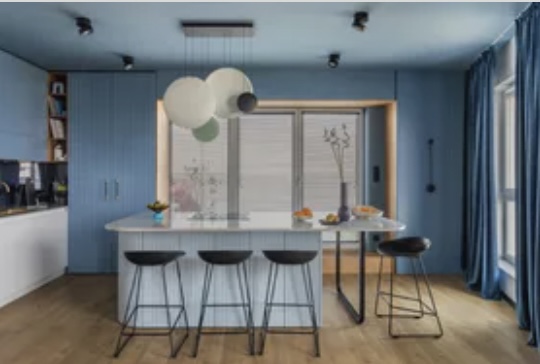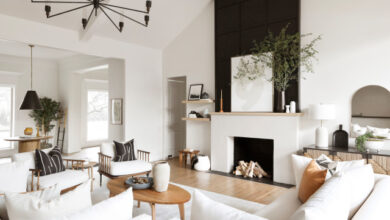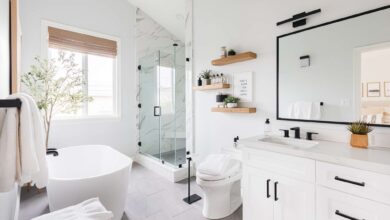How to Make Your Home Feel and Look Bigger


Homes, and the rooms that comprise them, are by nature finite spaces. However, that fact shouldn’t stop us from making our homes feel vaster. After all, limitation, as they say, breeds innovation. Thankfully, you don’t have to reinvent the wheel as there are already several tried and true methods for making your home feel more spacious. We spoke to two renowned interior designers, Tim Hobby of HA Modern and Candace Griffin of Candace Mary Interiors, about the ways—big and small—to make your home feel and look more expansive.
Small Upgrades to Make Your Home Feel Bigger
Table of Contents
Use Paint to Your Advantage
“Painting is one of the easiest and most affordable things anyone can do to transform a room—and this includes making the room feel larger,” says Atlanta-based designer Tim Hobby. (Hobby runs a 7000-square-foot showroom, Minotti by HA Modern, in the Atlanta Decorative Arts Center, which features furniture by the Italian manufacturer Minotti.) “I love using shades of white in strategic ways: Instead of selecting just one shade, bring two or three shades together, using a different shade for the walls, trim, and the ceiling,” he says. Keep the lighter shade on the ceiling and play with the other shades on the walls.
“If you have crown molding and base molding, paint them both the same color to keep things clean and simple, and it will make the wall feel taller,” Hobby adds.
Pay Attention to Scale
The scale of furniture is paramount when dealing with a small room or small home. “You want the rooms to feel balanced to their size and not overwhelmed by large-scale furniture,” Hobby says. “This doesn’t mean the furniture has to be small or uncomfortable, just appropriately scaled.”
When selecting smaller-scale furniture, the seating height is also important to keep in mind. Furniture that’s lower to the ground will leave more vertical space open above it and make the room feel larger. Seat depth is also important to keep in mind, as seats that are too deep can take up extra floor space and crowd the room.
Chicago-based designer Candace Griffin tends to agree, but she adds a caveat. “There’s a fine line between overcrowding a room and not adequately filling the space,” she says. “Don’t, for example, if you’ve got room for a sofa, select a loveseat, as this will have the opposite effect from what is intended and will actually [visually] shrink the room.”
Griffin also advises removing unnecessary clutter and items so the eye has a visual break and there is room to move freely through the space. She offers an additional scaling tip: “Size up your rug! Rug sizing plays a major part in the scale of your room. If your rug is too small, it will shrink the entire space.”
Add Drama With Drapery
An all-too common mistake people make with window treatments is to hang drapes from the top of the window rather than from just below the ceiling. “Hanging drapes from ceiling to floor creates the illusion of higher ceilings and taller walls, thereby elongating the entire space,” says Griffin, who has a special talent for highlighting the personality of every space she touches, whether that be through design work or home staging.
Keep Decor Consistent
In a small home, the aesthetic flow from room to room is key as overtly different design ideas fragment the spaces and thus make them feel smaller. “I suggest having a color palette that continues from room to room, linking the rooms as opposed to each room being different,” Hobby says. “Using the same floor materials throughout the rooms will help achieve this as well, and keeping the same style of furniture consistent throughout will also help the home flow and feel like a connected space.”
Big Changes to Make Your Home Feel Bigger
Windows, Windows, Windows
Adding windows to your home or increasing the sizes of existing windows is a fantastic way to make a small home feel larger. According to Hobby, creating more natural light for the interior of the home and increasing the view to the exterior is one of the best ways to upgrade your home while making it feel more generous in size. “If you have the opportunity, take a set of windows and turn them into double glass doors that may lead to the exterior, like a porch or courtyard,” he says. “The taller the windows and glass doors, the better.”
Reconfigure the Layout
It can be hard to picture your home beyond the pre-determined rooms and floor plan, but Hobby says you shouldn’t be afraid to reconfigure the layout. Doing so can also help you better tailor your home to your lifestyle. “Homes often have larger dining rooms that are the least used room in the house, for instance,” he says. “Turning this room into a media room or expanding the kitchen into this room can be a very smart move to make a home feel larger and have a better flow.”
Hobby is currently working on a project where he transformed a capacious dining room into a stylish media room. The kitchen now holds a more modest dining area instead, which is better suited to the small family living there. Hobby and his team also added a dining table outdoors to accommodate larger gatherings and entertainment.
Griffin is also a proponent of playing with the layout of the home. “If the layout of your home supports it, consider opening up a kitchen wall to create an open concept,” she suggests. “This is great for entertaining and can instantly make your space feel larger.”
Expand by Enclosing
“If you have a porch or terrace on your home, enclosing it and opening it up to the interior of the house will increase your living space while also adding value to your home,” Hobby says. If, for instance, you love spending time on your front porch, enclosing it can turn it into a sunroom, adding to your livable square footage. “I love a metal and glass enclosure which can work on the front or the back of a house,” says Hobby. However, if you don’t want to enclose these areas, he suggests adding a wall of sliding doors to open the house to the exterior and promote a better flow between indoor-outdoor living. “This can be particularly successful in a kitchen or entertaining space,” he explains.
Finish the Basement and/or Attic
If you live in a home with an unfinished basement or attic, finishing these spaces does wonders for making your home feel bigger. “With attic renovation, be sure at least half of the ceiling is at least seven feet high and ensure that the attic is connected to a stairway,” Griffin says. There’s so much you can do with a finished attic, including turning it into a guest bedroom, office space, or even a home gym.
In much the same way, completing your basement offers potential for introducing rooms with different purposes, such as a home theater or media room. “If you plan to build a basement bedroom, remember to add emergency windows or a backyard walkout to your renovation plan,” Griffin says.
The best option to make your home feel and look larger will depend on your space and lifestyle—but it always helps to get creative. Think outside of the constraints of what your home looks like now, and instead imagine what it could look like with a couple upgrades or strategic renovations.




